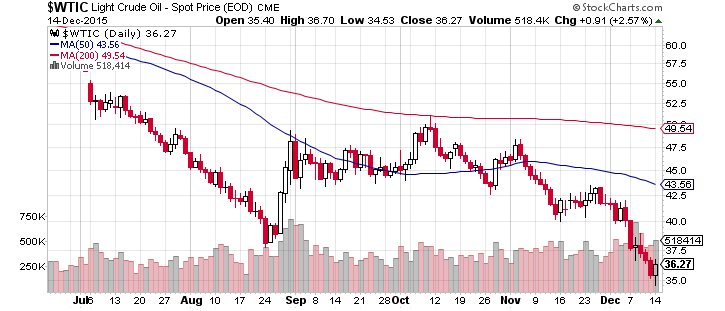Crude oil production remained stronger than anticipated throughout 2015 and this was instrumental in pushing crude prices lower. Unlike in the past, rather than cutting output in an attempt to sustain prices, the Organization of the Petroleum Exporting Countries (OPEC) continued to ramp up production.
US Oil futures dropped to $34.67 a barrel in New York on Monday, the weakest level since February 19th 2009, after posting a decline of over 10% last week, the sharpest fall in a year. It hardly came as a surprise after OPEC oil ministers effectively dropped any reference to the group’s production limits (previously standing at 30 million barrels per day) for the first time in decades at its meeting on December 4th.
The catalyst was represented by ongoing disagreements between Saudi Arabia and Iran on how to deal with Iranian output once Western sanctions are dropped. However, disputes over the group’s long term strategy are notoriously strenuous and as old as the group itself. One could only ask how long OPEC’s smaller members can survive, with their budgets only balancing with the oil prices way above the current levels.
To make things worse, Amir Hossein Zamaninia, the Iranian Deputy Oil Minister for International and Commerce Affairs, said there’s ‘absolutely no chance’ his country will delay plans to increase shipments even if crude prices drop. He expects sanctions over the country’s nuclear programme to be lifted by January 2016 and added that Iran already secured clients for its oil supply expansion.

Meanwhile, the wide consensus that US shale oil production has survived much better than many initially predicted after costs were dramatically cut. It appears that marginal costs were brought down in the last year and a half from above $70 per barrel to $50, according to US Energy Information Administration. Furthermore, US senators are getting close to striking a deal to allow oil exports for the first time in 40 years.
It should be added though that non-OPEC supply could decline next year after low oil prices might trigger a string of bankruptcies among high cost players. The U.S. Energy Information Administration (EIA) also reports that investment in global oil output has already dropped around 25 – 30% over last year and is predicted to continue to fall next year which will mark the first time in two decades when investment declined for two consecutive years.
Things look a tad brighter on the demand side, with the Paris based International Energy Agency seeing a rise of about 1.8 million barrels in 2015, almost double the rise in 2014. Additionally, going against the consensus is Capital Economics which expects demand to grow rather strongly in 2016 based on an increased in sales of SUVs. In China, oil demand grew at 4% before mid 2014 and increased at an average of 6% after.
In the Middle East, there is an ongoing risk of crude exports disruptions which should also act as some support going forward.
The million dollar question remains, will a potential fall in non-OPEC supply, combined with growing global demand, be able to offset a rise in OPEC production and an existing glut in inventories? Only time will tell.

















